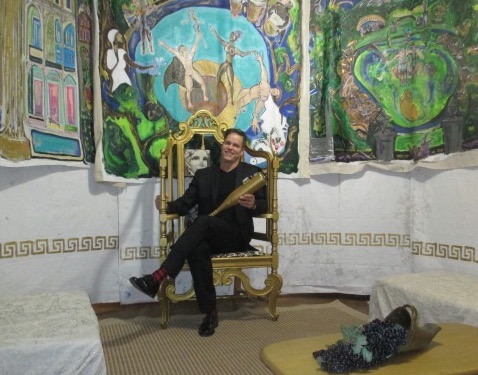
Morgan Molthrop enjoying artwork in Alexander the Great’s campaign tent.
As a junior in Dr. Arthur White’s Western Civilization class at Isidore Newman School, Morgan Molthrop became enthralled with Alexander the Great. This was not just a story, he realized, but the life and accomplishments of one of the most influential people in human history. Alexander III of Macedon, who conquered Persia, expanding the Greek Empire all the way to the Indus River, assumed monumental status, not only ruling over other peoples, but spreading Hellenistic civilization, including science, literature, philosophy, democracy and the arts across a continent.
Molthrop read everything he could find from The Alexander Trilogy biography by Mary Renault to Alexander the Great by Oxford scholar Robin Lane Fox. When Alexander was crowned king at age 20, after his father’s assassination, he quickly consolidated power.
“I’ve always been interested in what makes a person successful, unique, creative, dynamic, and Alexander was the most fascinating figure who ever lived,” says Molthrop, author of books that examine the successes of Gen. Andrew Jackson and Jean Lafitte. His thoughts returned to Alexander the Great, but as he began to write a fictional novel from the point of view of Alexander’s lover, Hephaestion, Molthrop decided he needed to see the places Alexander had lived to truly understand. He flew to Greece for a pilgrimage.
“I started my journey in the town of Dion where at 10 years of age, Alexander met his stallion, Bucephalas. The unruly horse was said to be ‘unrideable’ except by the ruler of the world.” The boy tamed Bucephalus and later rode him into battles as far as India.
Molthrop traveled to Alexander’s birthplace in Macedon and visited the Temple of the Nymphs where Aristotle instructed the boy in medicine, philosophy, morals, logic and art. He began to fantasize what might happen if Alexander were to visit New Orleans in current day. Could the charismatic leader bind the city together, solving its endemic problems?
“The city is full of Greek Revival architecture and symbolism. I wanted to ignite interest in this fascinating character and historical period,” Molthrop says.
“More than any city in North America, Alexander would be intrigued by New Orleans. His multicultural tastes and the spectacle of Mardi Gras — along with the mysteries of Vodou and the physical beauty of the landscape — would combine with his driving impulse: to ‘cut the Gordian knot’ a nd solve the issues of community,” he says.
nd solve the issues of community,” he says.
Out of Molthrop’s lifelong fascination has evolved an art show and gala to be held 7:00 – 10 p.m., Jan. 12 at the New Orleans Art Center (3330 St. Claude Avenue). Molthrop painted seven colorful, epic paintings of Alexander’s imagined visit on enormous canvases, including Audubon Park, Gallier Hall, 1884 World’s Fair, Congo Square, Canal Street, New Orleans Athletic Club and Mississippi River. The hand-printed murals are displayed inside a 300-square foot “campaign tent” since Alexander spent most of his days afar on military conquests.
At the gala, Alexander the Great Visits New Orleans, Alexander will toast kings and queens from several downriver krewes.
The event is a benefit for The Creative Alliance of New Orleans (CANO), which provides training, education and information for creative artists, cultural producers and the community to protect New Orleans cultural legacy and promote the revitalization of the city as a cultural and economic center.
Tickets are $35 and can be purchased at Eventbrite.com, and the link can be found on the event’s page.
 NOLAbeings Multimedia artist Claire Bangser created NOLAbeings as a portrait-based story project that marries...
NOLAbeings Multimedia artist Claire Bangser created NOLAbeings as a portrait-based story project that marries...  Voodoo in New Orleans: Reviving history: New Orleans fortune telling This article takes a deep dive into the history of Voodoo in New Orleans, its hybridization with Catholicism, and its present-day place in the city's culture. The author visits fortune-tellers in the French Quarter, using their guidance as a tool for introspection rather than a deterministic predictor of the future. Through her experiences in New Orleans, the author feels a mystical connection to both the past and the future.
Voodoo in New Orleans: Reviving history: New Orleans fortune telling This article takes a deep dive into the history of Voodoo in New Orleans, its hybridization with Catholicism, and its present-day place in the city's culture. The author visits fortune-tellers in the French Quarter, using their guidance as a tool for introspection rather than a deterministic predictor of the future. Through her experiences in New Orleans, the author feels a mystical connection to both the past and the future. 